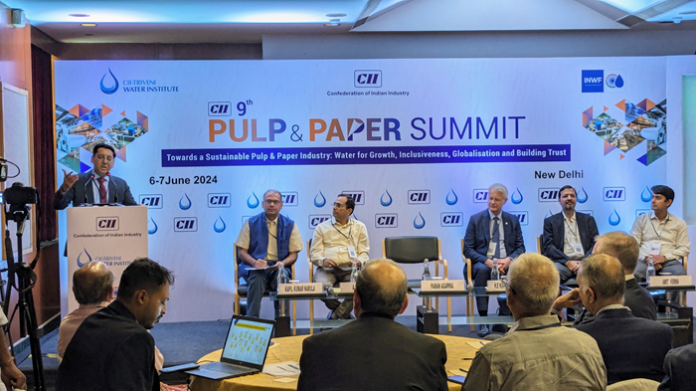
The 9th edition of the CII Pulp and Paper Summit, held on 6 and 7 June at the India Habitat Center, brought together industry leaders and experts to address the pressing challenges and opportunities within the pulp and paper sector. This year’s conference was marked by a strong focus on sustainability, technological innovation, and the critical role of the industry in various governmental initiatives.
Pawan Agarwal, the summit chairman and president of the Indian Papers Manufacturers Association, set a positive tone in his keynote address by declaring the current era as an exciting time for the pulp and paper industry. He emphasized the growing recognition of paper’s importance, particularly in the context of sustainability. He highlighted that the industry’s products are now seen as valuable assets in efforts to reduce environmental impact, especially given the increasing awareness of the detrimental effects of plastic and other non-biodegradable materials. Agarwal also noted that the paper industry is integral to numerous government schemes, “Every scheme of the government is heavily dependent on the paper industry.”

Photo- IPP
Despite the optimism, Agarwal did not shy away from discussing the significant challenges faced by the industry, particularly concerning the availability of raw materials. He pointed out that the scarcity of raw materials remains a persistent issue, one that could potentially affect the growth and sustainability of the sector. “To overcome these challenges, we must embrace innovation and technological advancements. We have to adopt and adapt to technologies,” Agarwal urged to the industry stakeholders calling for a proactive approach to problem solving.
Water conservation and sustainability
Water conservation emerged as a critical topic during the conference, with several speakers underscoring its importance. Pawan Khaitan, president of the Indian Pulp & Paper Technical Association, expressed deep concern over the industry’s water wastage. Khaitan said sustainability should encompass the entire production process. “We must adopt sustainability not only in our products but in our process as well.”
Discussing water issues, the concept of zero discharge resonated throughout the summit. Zero discharge refers to the complete elimination of wastewater from the production process, thereby significantly reducing environmental pollution and conserving vital water resources. The speakers unanimously agreed that achieving zero discharge is an essential step toward sustainable technology in the pulp and paper industry.
Amit Verma, director, Niti Ayog said, “By adopting zero discharge technologies, the pulp and paper industry can lead by example in sustainable manufacturing practices. The implementation of such technologies would not only benefit the environment but also enhance the industry’s reputation as a responsible and forward-thinking sector.”
Collaborative efforts, policy reforms, and financial constraints
In the panel discussion on policy and reforms, Sushil Gupta, a member of the Punjab Water Regulation and Development Authority, urged the government and the private sector to collaborate closely to drive meaningful change in the industry. “There are many discussions on collaborations, but the real groundwork is missing, we need to work on that to make the decisions fruitful.”
According to AK Vidyarthi, a scientist at the Central Pollution Control Board, other than collaborations, integration of technology and measuring its financial constraints are the key to the industry’s sustainable operation. He stressed that any new policies and reforms should be developed through extensive consultation and must ensure financial sustainability. Vidyarthi said that overcoming financial constraints is crucial, and can be achieved through proper technology and planning.
Sunil Kumar, former chairman of Central Ground Water Board, also spoke on financial constraints. During his time on the dias, Kumar pointed out that the pulp and paper industry is the third largest water-consuming industry. He said the sector should take the lead in conserving water by implementing technologies that manage costs effectively. Kumar’s remarks underscored the need for a balance between technological advancement and financial viability, highlighting that sustainable practices should not come at the expense of economic stability.
The conference featured presentations from various companies working on technology implementation for water conservation and the utilization of treated water. These sessions showcased innovative solutions aimed at reducing water consumption and promoting the use of recycled water in the production process.















